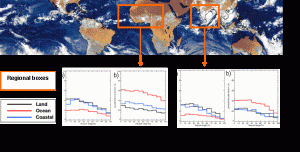The analysis of the morphology of tropical convective systems has received much attention mainly thanks to the advent of geostationary infrared data. Statistics on the size, duration, propagation of the systems as well as the link to the thermodynamical and dynamical environment is readily acquired. Climatology of the tropical systems morphology is now built from roughly 25 years of continuous observations (e.g., Fiolleau et al., 2007).
On the other hand most of our knowledge on the life cycle of the tropical systems from a physical point of view (rainfall distribution, latent heating and radiation cooling rate vertical distribution, water transport, shear etc…) mainly arises from individual observational campaigns heavily based on ground radar observations and CRM modelling. Use of event-based approach exploiting the TRMM/PR data improves greatly the situation (Liu et al, 2008). The Megha-Tropiques mission, thanks to its sampling offers the possibility to further bridge the numerous individual case study physical observations and the climatological morphological approach (e.g. Kondo et al. 2006, Futyan and Del Genio, 2007).
The present product introduces a compositing technique aiming at such endeavor.
Tracking of the Convective Cloud Systems

Using the GEO data and the tracking, life cycle of the various MCS are formed. Then using the BRAIN-MADRAS Level 2 products and the level-2 ScaRab products, collocation in space and time of the rain products and the MCS cloud shield and of the radiative products and MCS cloud shield are looked for. Given the sampling of Megha-Tropiques, only some stages of the MCS life cycle are documented with the rain and radiative information. Then these observed stages are composited over many systems forming a continuous view of the rainfall and radiative distribution within the life cycle of a MCS.Composites are formed for each season over a suite of regions that cover the rainfall seasonal variability. For each regional box, cloud systems composite are constructed separating the land, ocean and coastal systems. The figure below illustrates the product (only for the rain information).
The details of the algorithm are available in the Megha-Tropiques Technical Memorandum n°5 (Fiolleau et al.,2012a)

Figure 2: Example of the final composite product constructed here over many seasons of TRMM/TMI and METEOSAT observations.
For more information, contact Rémy Roca (remy.roca@legos.obs-mip.fr).
References:
Arnaud Y, Desbois M, Maizi J, 1992. Automatic tracking and characterization of African convective systems on meteosat pictures, Journal of Applied Meteorology, 31: 443-453.
Fiolleau et al, A climatology of Mesoscale Convective Systems from 23-years of METEOSAT first generation observations, AMMA conference, november 26,30 2009; article to be submitted
Fiolleau Thomas, Rémy Roca, Jérémie Aublanc, Olivier Chomette, Patrick Raberanto, Nicolas Gif, 2012: Composite of convective systems: a Megha-Tropiques products, Algorithm Theoretical Basis Document, Megha-Tropiques Technical Memorandum n°5
Futyan and Del Genio,2007, Deep Convective System Evolution over Africa and the Tropical Atlantic, J Climate, pp 5041-5060, DOI: 10.1175/JCLI4297.1
Kondo, Y, A. Higuchi and K. Nakamura, 2006: small-scale cloud activity over the maritime continent and the western Pacific as revealed by satellite data. Mon. Wea. Rev., 134, 1581-1599.
Liu, C., E.J. Zipser, D.J. Cecil, S.W. Nesbitt, and S. Sherwood, 2008: A Cloud and Precipitation Feature Database from Nine Years of TRMM Observations. J. Appl. Meteor. Climatol., 47, 2712-2728.
Mathon V, Laurent H. Life cycle of Sahelian mesoscale convective cloud systems. Quart J Roy Meteor Soc 2001 ; 72 : 105-10